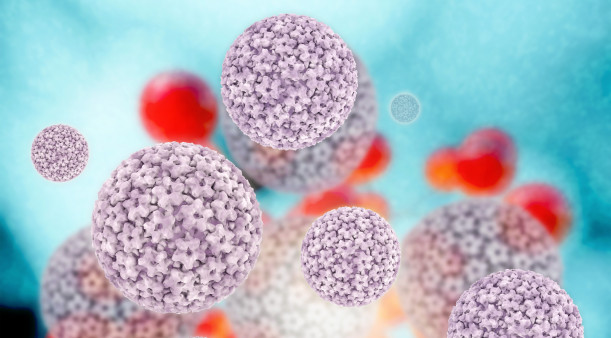Sexually transmitted infections (STIs) besides human papillomavirus (HPV), especially chlamydia, may increase the risk of developing anal cancer among HIV-positive gay and bisexual men, according to a recent study. The analysis also revealed a link between precancerous cell changes and HPV types not usually associated with cancer.
HPV is one of the most common STIs, and most sexually active people will acquire some of the more than 150 known types of the virus. HPV triggers abnormal cell growth that can lead to precancerous cell changes known as dysplasia or neoplasia and, if left untreated, invasive cancer of the anus, cervix, vulva, vagina, penis or mouth and throat. The Gardasil 9 vaccine protects against the two main oncogenic, or cancer-causing HPV types (16 and 18), five additional high-risk types (31, 33, 45, 52 and 58) and two types that cause genital and anal warts (6 and 11).
People living with HIV have more types of HPV on average and are less likely to clear the virus naturally. They may also experience more rapid progression of HPV-related disease, from low-grade cell changes to high-grade intraepithelial neoplasia to invasive cancer. About half of HIV-positive men who have sex with men (MSM) have high-grade anal neoplasia, and they have up to a 100-fold greater risk of anal cancer than the general population, according to Joel Palefsky, MD, of the University of California at San Francisco.
Mar Masiá, MD, of Hospital General de Elche and Universidad Miguel Hernández in Alicante, Spain, and colleagues looked at the relationship between STIs and high-grade anal intraepithelial neoplasia (HGAIN) in 145 HIV-positive MSM seen at the Spanish hospital. The media age was about 45. Nearly 90% had HIV viral suppression and the CD4 cell count was high, at around 600, but nearly 20% had a past history of AIDS.
The participants in this prospective study underwent high-resolution anoscopy, which uses a lighted microscope to view anal tissue abnormalities, along with anal-rectal swabs to test for STIs and anal biopsies to collect tissue samples for further analysis. Forty-nine of the men received two anoscopies.
Swabs were tested for multiple types of HPV as well as several bacterial STIs including Chlamydia trachomatis, Neisseria gonorrhoeae, Ureaplasma urealyticum (which causes urinary tract infections) and Mycoplasma species. Chlamydia has been linked to a higher risk of cervical cancer in women, but its association with anal cancer has not been well studied.
The researchers found, as expected, that most participants (88.3%) tested positive for some types of HPV; 84.1% had high-risk types. More than a quarter (26.2%) tested positive for HPV16, followed by HPV52 (20.0%), HPV53 (19.3%), HPV42 (19.3%), HPV58 (18.6%) and several less common types. In all 49 men who received a second anoscopy, HPV16, HPV53 and HPV70 persisted over time.
In addition, although none of the men had sores or other STI symptoms, 17.2% were found to have Ureaplasma urealyticum, 13.8% had Mycoplasma hominis, 9.0% had chlamydia, 2.8% had Mycoplasma genitalium and 2.1% had gonorrhea.
Thirty-five participants (24.1%) were diagnosed with high-grade anal neoplasia during their first anoscopy and thirteen (26.5%) were diagnosed during their second anoscopy. Among the 49 men who underwent repeated anoscopies, 21 (42.9%) had evidence of HGAIN on one of the two tests.
In a univariate analysis looking at single factors, high-grade anal neoplasia was associated with HPV types 16, 53, 61, 68, 69 and 70, as well as chlamydia, Ureaplasma urealyticum and Mycoplasma genitalium.
In an adjusted analysis that controlled for multiple factors, HPV16, HPV53, HPV70 and chlamydia remained significant predictors of HGAIN, meaning the association was probably not driven by chance. There was also a significant interaction between chlamydia and HPV16, indicating that men with both infections had a 31-fold higher risk of advanced neoplasia—far higher than those with either infection alone.
"Coinfection with Chlamydia trachomatis may potentiate the oncogenic capability of HPV16 so that, when both pathogens coexist, the risk for HGAIN increases substantially compared with either infection alone in HIV-positive MSM,“ the study authors concluded. ”Accordingly, individuals coinfected with both pathogens would be at increased risk for the development of anal cancer."
The researchers also suggested that HPV53 and HPV70—types not usually linked to cancer—should be considered among the genotypes associated with high-grade anal neoplasia.
"Because of the high and growing frequency of infection with Chlamydia trachomatis in MSM and the paucity of related symptoms, as observed in our cohort, screening and eventual therapy for this pathogen should be considered among measures to prevent anal cancer," they wrote.
HPV and chlamydia often do not cause symptoms at early stages. Regular screening for bacterial STIs including chlamydia is recommended for sexually active gay and bi men. Men taking pre-exposure prophylaxis (PrEP) are advised to receive STI tests every three to six months. Chlamydia can be treated with antibiotics, but there is currently no antiviral treatment for HPV.
Anal cancer screening is not routinely recommended, though some experts think it should be for people at high risk—including HIV-positive MSM—based on the dramatic drop in cervical cancer deaths after the widespread introduction of cervical Pap smear screening. If a Pap test shows abnormal cell growth, precancerous tissue can be removed before it progresses to cancer. The ongoing ANCHOR trial is evaluating whether screening and treating high-grade anal neoplasia can prevent anal cancer (AnchorStudy.org or 844-HIV-BUTT).
The Gardasil 9 HPV vaccine is recommended for boys and girls at age 11 or 12, with catch-up vaccination for men and women up to age 26. In 2018, the Food and Drug Administration approved Gardasil 9 for men and women up to age 45. The vaccine is not as effective for older individuals, who typically have been exposed to moreHPV types, but some people between the ages of 27 and 45 may not yet have all of the virus types covered by the vaccine and could potentially benefit. Researchers are currently working on a vaccine to prevent chlamydia.
While widespread HPV vaccination can offer major public health gains by reducing the occurrence of precancerous cell changes—and, ultimately, cervical, anal, oral and other HPV-related cancers—this study shows that HPV types not covered by the vaccine may also contribute to the development of cancer.
Click here to read the study abstract.
Click here to learn more about anal cancer.
Click here for a POZ feature on people living with HIV and cancer.







Comments
Comments